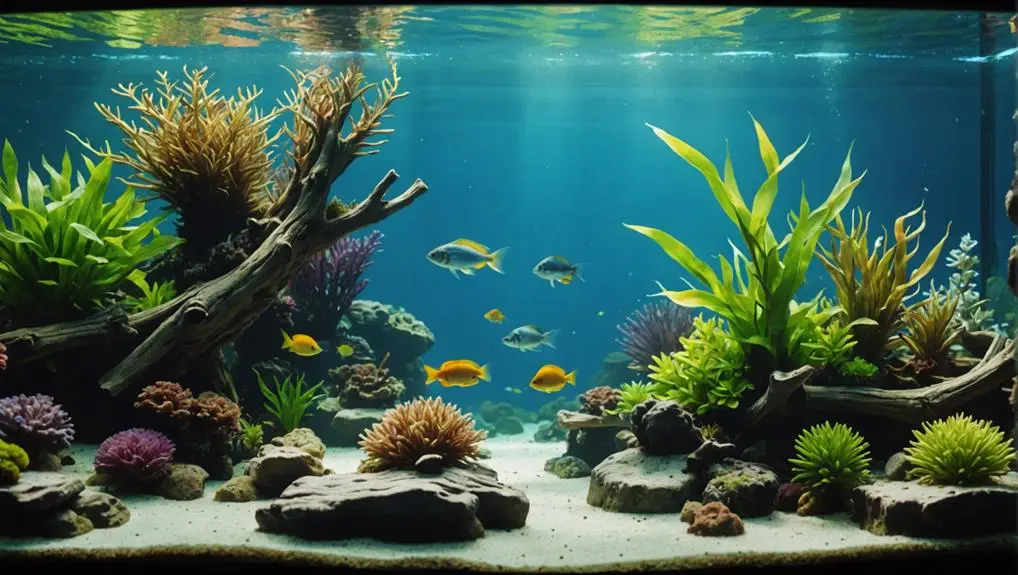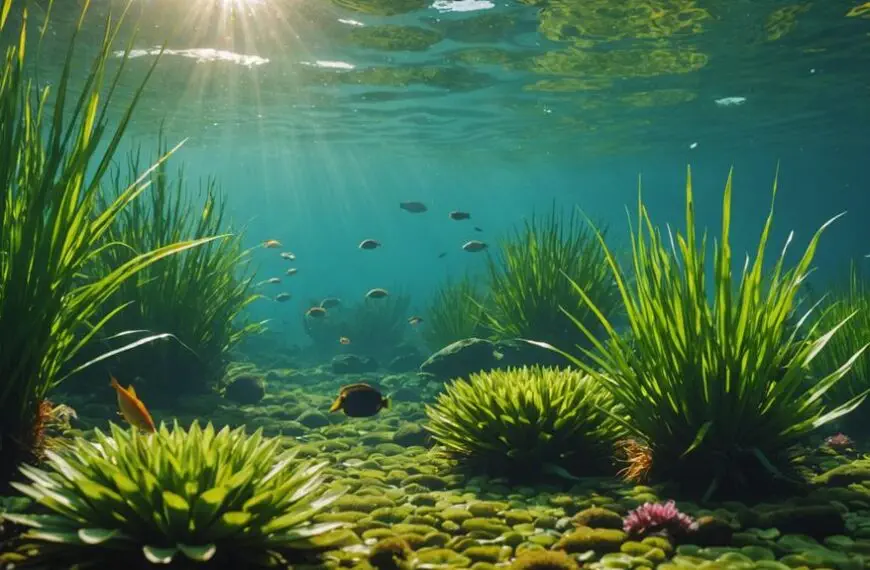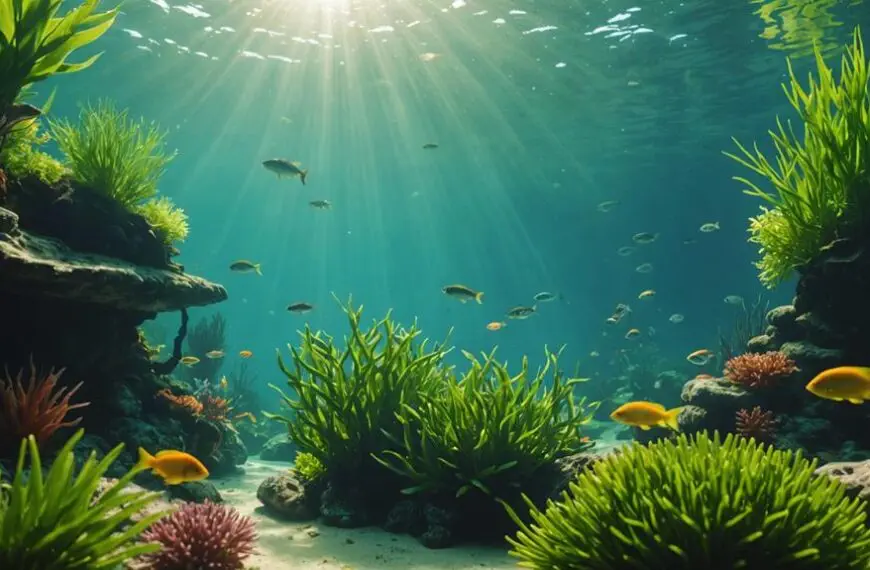Want to set up an eco-friendly aquarium? Start small—think 5 to 10 gallons. Smaller tanks use less energy and are easier to manage. Fill it with native plants; they look great and help keep the water clean! Swap your old bulbs for LED lights to save on power, and keep your fish cozy with adjustable, energy-efficient heaters. Use efficient filters to maintain water quality, and don't forget regular maintenance, like water changes and plant pruning. Planning for fish growth and engaging with local aquarium communities can make your setup even more sustainable. Stick around, and you'll discover more handy tips!
Contents
Think Small
Why not start with a smaller aquarium when diving into the world of fishkeeping? A tank that's 5 to 10 gallons is perfect for beginners. It's like dipping your toes into the water instead of diving straight in!
Smaller tanks use less energy, which is great for both your wallet and the environment. Plus, you won't need a massive filtration system that guzzles electricity.
When you think small, consider freshwater fish like guppies and bettas. They're fantastic companions and thrive in compact spaces. Just remember, steer clear of fish bowls! They often lead to poor water quality, making your fish stressed and unhappy.
A small aquarium provides a healthier environment where your aquatic friends can flourish. Starting with these manageable setups helps you gain confidence in your fishkeeping skills. You can learn the basics without feeling overwhelmed, and before you know it, you'll be ready to tackle larger, more complex tanks.
Choose Native Plants
Choosing native plants for your aquarium not only enhances the beauty of your setup but also supports local ecosystems. Imagine creating a vibrant underwater world that mirrors your local waterways!
Native plants are perfectly adapted to your region's water conditions, so they'll thrive with less maintenance. This means you'll spend less time fussing over your plants and more time enjoying them.
By incorporating these local flora, you're also improving water quality. Native plants act as natural filters, helping to keep your aquarium clean and healthy. They've evolved to flourish in the same environment as your fish, making it a win-win situation!
Plus, since they're suited to the nutrient profile of your water source, you can say goodbye to chemical fertilizers. Who needs that extra hassle?
Not only do native plants help sustain local ecosystems, but they also bring a unique aesthetic to your tank. Resilient and easy to care for, these plants can make your aquarium a showstopper without the stress of exotic species.
Use LED Lighting
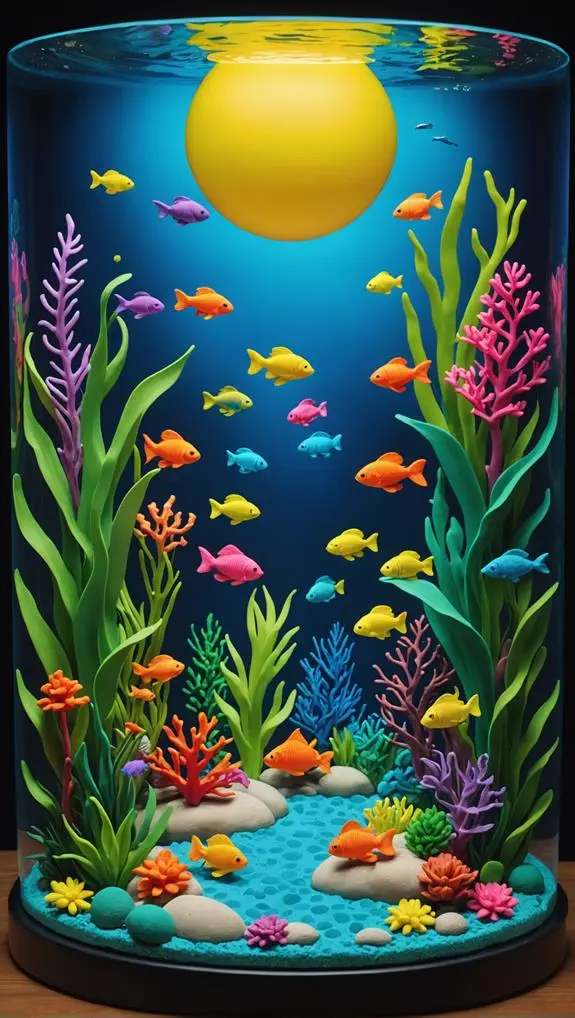
When you switch to LED lighting for your aquarium, you're not just saving money; you're also saving the planet.
These little wonders use about 75% less energy than those old-school bulbs, which means more cash in your pocket and less strain on the environment.
Plus, with a lifespan of up to 25,000 hours, you'll be spending less time swapping out lights and more time enjoying your beautiful underwater world!
Energy Efficiency Benefits
Using LED lighting in your aquarium not only enhances the visual appeal but also offers significant energy efficiency benefits.
You'll be amazed at how much you can save on your electricity bill while doing your part for the planet.
Here are some key advantages of switching to LED lights:
- Lower energy consumption: LED lights use up to 75% less energy than traditional bulbs, keeping your costs down.
- Tailored wavelengths: You can choose specific LED lights that emit wavelengths perfect for helping your plants grow, creating a thriving ecosystem.
- Less heat production: LEDs produce minimal heat, so you won't need extra cooling methods, further reducing your energy consumption.
- Customizable settings: Many LED systems let you adjust brightness and color, allowing you to create the ideal environment for your aquatic friends.
Longer Lifespan Advantage
Switching to LED lighting not only boosts energy efficiency but also provides a remarkable advantage in lifespan.
Imagine this: while traditional fluorescent bulbs fizzle out after about 10,000 hours, LEDs can shine on for up to 50,000 hours! That means less hassle replacing bulbs and less waste piling up.
These energy-efficient lights don't just save you time; they also save you money.
With LEDs consuming up to 75% less energy than incandescent bulbs, your electricity bills will be lighter, too! Plus, since they emit less heat, you'll help maintain stable water temperatures in your aquarium, keeping your fish and plants happy without needing extra cooling methods.
Another perk? You can customize the wavelengths of LED light to meet the specific needs of your aquatic plants and fish.
This tailored approach promotes healthier growth and keeps algae blooms at bay—talk about a win-win!
Sure, the initial cost of quality LED systems might be higher, but their long lifespan and efficiency mean you'll save in the long run.
Optimize Heating Systems
When it comes to keeping your aquarium cozy, choosing the right heater is key. A heater that fits your tank size not only keeps things toasty but also saves you some cash on energy bills—who doesn't love that?
An adjustable heater is essential for maintaining the ideal temperature range for tropical fish, ensuring their comfort and health proper heater selection.
Plus, by making a few smart adjustments, like insulating your tank and checking on your heater regularly, you can create a warm, happy home for your fish without breaking the bank.
Heater Selection and Size
Optimizing your aquarium's heating system starts with selecting the right heater size and type for your tank. Choosing the right heater isn't just about keeping your fish cozy; it's also a key part of efficient energy use.
Here are some tips to help you make the best heater selection:
- Power it Right: Use the rule of 3-5 watts per gallon for tropical fish to determine the appropriate wattage based on your tank size.
- Adjustable Heaters: Invest in an adjustable or programmable heater to set specific temperatures, preventing energy waste and ensuring your fish stay happy.
- Submersible Choices: Opt for submersible heaters, as they provide better heat distribution. No one likes hot spots, right?
- Safety Features: Look for heaters with built-in thermostats or overheat protection. These features not only enhance energy efficiency but also protect your aquatic buddies from temperature stress.
Temperature Consistency Importance
Temperature stability in your aquarium is vital for the health and well-being of your fish. When water parameters fluctuate, your fish can experience stress and illness. Most species, like bettas, thrive in a cozy 78-80°F range. So, investing in a quality heater that fits your fish tank's size is essential—think 75-watt for up to 20 gallons.
But it doesn't stop there! Position your aquarium away from windows and drafts. This simple step helps maintain consistent heating and keeps your fish happy. Regularly check your heater's functionality and adjust the settings as needed. A malfunctioning heater is like a surprise heatwave for your aquatic pals, leading to rapid drops or spikes in temperature.
You'll also want to consider insulation. A well-insulated tank not only nurtures beneficial bacteria but also saves energy. It's a win-win!
Energy-efficient Heating Solutions
Choosing energy-efficient heating solutions is crucial for maintaining a healthy aquarium environment while keeping your energy bills in check. It's all about creating a cozy home for your aquatic friends without draining your wallet!
Here are some tips to help you optimize your heating systems:
- Select the Right Heater: Choose energy-efficient heaters designed for your aquarium's size. This minimizes energy consumption and ensures your fish are comfortable.
- Adjustable Heating Systems: Look for heaters that allow precise temperature control. This helps reduce energy waste and keeps conditions stable for your fish.
- Invest in Smart Technology: Programmable thermostats or smart plugs can automate your heating system. That way, it only operates when necessary, cutting down energy use.
- Position Your Aquarium Wisely: Place your tank away from cold drafts or windows. This enhances heat retention, reducing the workload on your heater and saving energy.
Select Efficient Filters
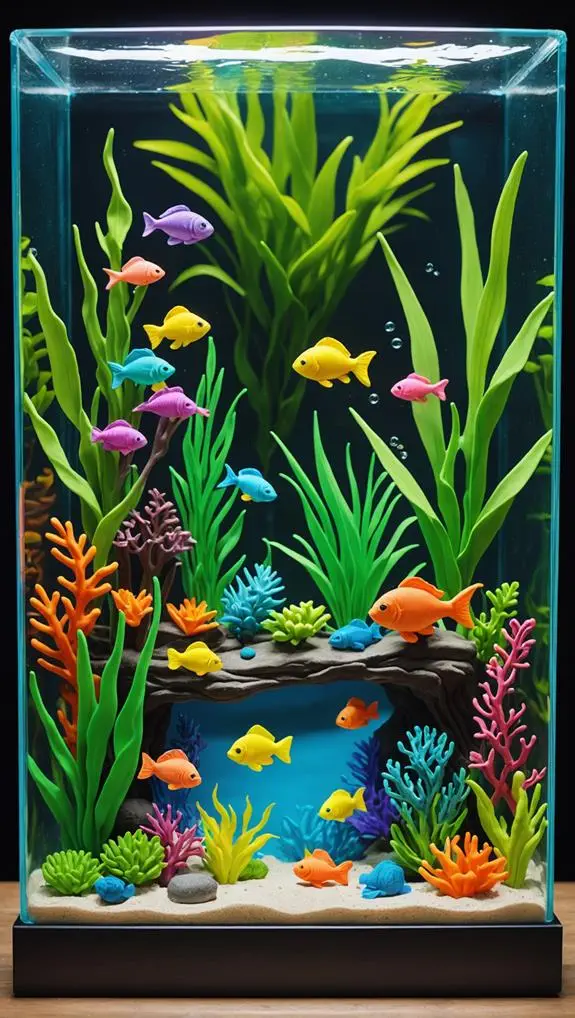
When setting up an eco-friendly aquarium, selecting the right filter is crucial for maintaining a healthy environment for your aquatic life. You want efficient filters that keep your water clean while minimizing energy consumption.
Start by choosing a filter that's appropriately sized for your tank; this ensures proper water circulation without wasting electricity. Additionally, consider the ideal filter flow rate to prevent waste accumulation and harmful bacteria growth, enhancing the overall water quality.
Energy-efficient models, like sponge filters or low-wattage canister filters, are great options. They help maintain clean water quality while keeping your energy bills in check.
Don't forget to regularly clean your filter—clogged filters can hog energy and struggle to do their job.
Also, consider filters that incorporate biological filtration. These filters support beneficial bacteria that break down waste naturally, meaning less heavy-duty cleaning for you.
Plus, filters with adjustable flow rates let you tailor water circulation to fit your tank's unique needs.
Avoid Saltwater Fish
Saltwater fish might seem appealing with their vibrant colors and diverse species, but they often come with significant challenges that can undermine your eco-friendly goals. Instead of getting caught up in the allure, consider these four reasons to avoid saltwater fish: Additionally, a properly cycled tank is essential for any aquarium, as it establishes a stable environment for the fish, preventing toxic spikes in ammonia and nitrite levels that saltwater systems are particularly susceptible to, especially during the initial setup phase.
- Complex Equipment: Saltwater setups often require pricey gear like protein skimmers and sump systems, which ramp up energy consumption and costs.
- Specialized Care: These aquariums need specific lighting and heating, making them harder to maintain than freshwater setups. You might find yourself spending more time and money than you bargained for.
- Disease Management: Dealing with illnesses in saltwater systems is tricky. Frequent interventions can increase your environmental impact, diverting you from sustainable practices.
- Eco-Friendly Alternatives: Freshwater fish thrive in simpler conditions, allowing you to create an aquarium that incorporates live plants. These setups support biodiversity and can even help prevent algae blooms.
Plan for Fish Growth
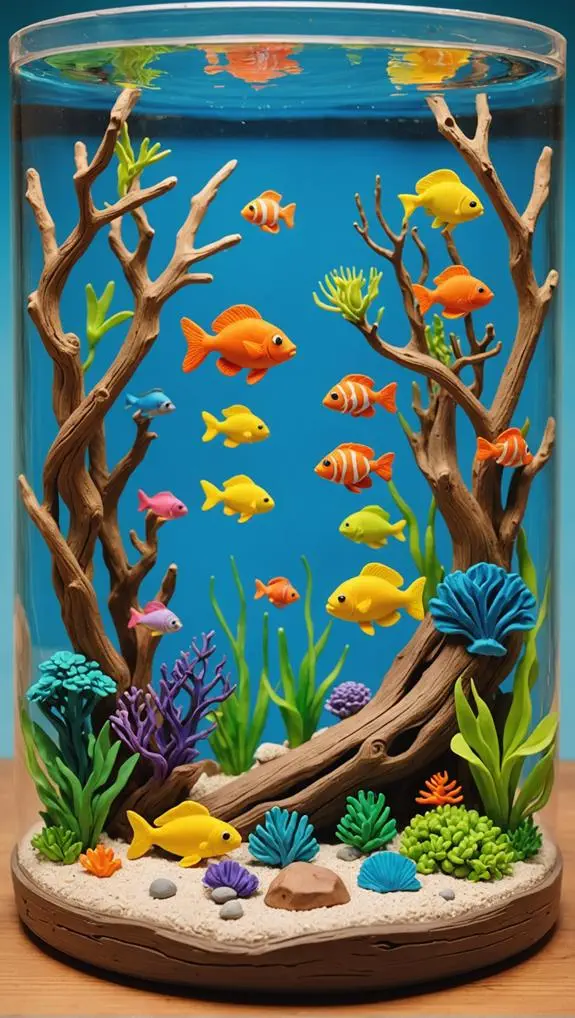
When you're picking out fish for your aquarium, it's super important to research how big they'll get as adults. Many species, like Cichlids and Oscars, require larger tanks as they grow, so it's essential to plan accordingly to avoid overcrowding and maintain water quality.
You wouldn't want to end up with a tiny tank for a fish that thinks it's a whale, right? Plus, making sure different species get along is key to keeping your underwater community happy and thriving!
Understanding species behavior will help you in selecting compatible tank mates.
Research Species Sizes
Researching species sizes is crucial for ensuring your aquarium is a healthy environment for your fish.
If you want your aquatic friends to thrive, you need to know how big they'll get! Here are some tips to help you plan accordingly:
- Look Up Adult Sizes: Before adding any fish, check their adult sizes. A neon tetra stays small at around 1.5 inches, while a goldfish can grow to a whopping 12 inches!
- Tank Size Matters: Make sure your tank can comfortably accommodate your fish. Overcrowding can cause stress and health issues, which isn't what you want for your finned friends.
- Follow the One Inch Rule: As a guideline, aim for one inch of fish per gallon of water, but remember that some species have unique space needs based on their behavior.
- Consider Growth Rates: Introduce community fish like platies gradually as they grow; it's less chaotic and helps maintain a balanced environment.
Ensure Compatibility Among Fish
Understanding how fish grow and interact is key to ensuring compatibility in your aquarium. You'll want to research the adult sizes of fish before purchasing them. This helps prevent overcrowding, which can lead to stress and unhealthy conditions.
Mixing community-friendly species, like neon tetras and platies, promotes harmony and reduces territorial disputes.
As your fish mature, keep an eye on their growth rates. Adjust the tank's stocking density when necessary to maintain a balanced ecosystem. It's also smart to choose fish that fill different roles in your tank. For instance, adding algae eaters like mollies keeps your aquarium clean, while bottom dwellers like hoplo catfish help with tidiness too.
Always purchase your fish from reputable dealers. This way, you avoid introducing endangered species or those that won't get along with your current tank mates. Plus, it promotes biodiversity, which is great for the environment!
Regular water changes also support your fish's health. By being mindful of these factors, you'll ensure compatibility among fish, creating a thriving, eco-friendly aquarium that serves both your aquatic friends and the planet well. Happy fishkeeping!
Embrace Self-Sustaining Aquariums
Self-sustaining aquariums are a fantastic way to dive into the world of eco-friendly fishkeeping.
They create a beautiful and balanced ecosystem that keeps the water clean with minimal effort. Plus, who doesn't love a little harmony in their fish tank?
Here are some tips to help you embrace this sustainable journey:
- Choose the Right Plants: Incorporate a variety of live plants that can help absorb nutrients and compete with algae growth, keeping your water clear and fresh.
- Select Suitable Fish: Opt for fish that thrive in low-flow environments. This promotes healthy interactions and ensures waste products are managed effectively.
- Use Quality Substrate: A mineral-rich soil capped with sand not only enhances root growth but also supports beneficial bacteria that play a vital role in maintaining water quality.
- Monitor Water Parameters: Regularly check your pH, temperature, and nitrate levels.
This keeps your ecosystem balanced, ensuring your fish and plants remain happy.
Practice Regular Maintenance
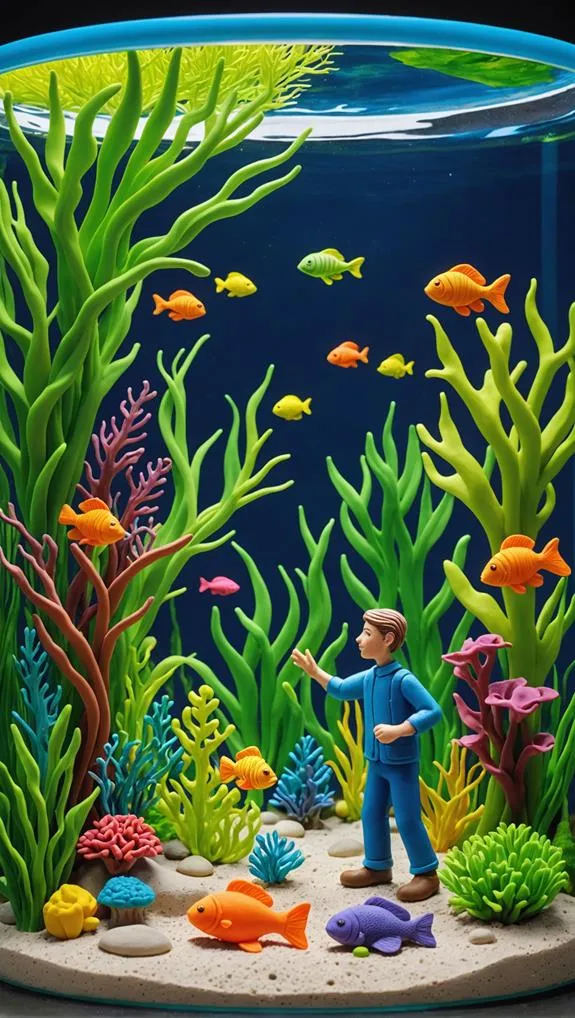
Maintaining an eco-friendly aquarium is just as important as setting one up. Regular maintenance helps you keep your aquatic friends happy and healthy, which is what we all want, right?
Aim for 10-20% water changes every two weeks. This simple step prevents toxic buildups of ammonia and nitrates, creating a safe space for your fish and plants.
Don't forget to monitor water parameters using test kits. Keeping an eye on pH, ammonia, nitrite, and nitrate levels ensures stability in your ecosystem. It's like checking the temperature before jumping into a pool—no one wants an unpleasant surprise!
Cleaning and maintaining filters regularly is another crucial task. This boosts water circulation and quality, helping to minimize energy use while supporting a thriving habitat. Plus, who doesn't love a clean tank?
Pruning aquatic plants and removing dead material is key to preventing algae growth. A little snip here and there keeps your aquarium balanced.
Lastly, check on the microbial balance often. Healthy microbes help with waste processing and nutrient cycling. By practicing regular maintenance, you're not just serving your fish; you're creating a beautiful underwater world for everyone to enjoy!
Engage With the Community
Engaging with the aquarium community can be a game-changer for your eco-friendly setup. By connecting with others who share your passion, you'll discover a wealth of knowledge that can help you create a thriving, sustainable aquarium.
Here are some ways to get started:
- Join Online Forums: Dive into discussions about eco-friendly practices. You'll learn from others' successes and challenges, and share your own experiences too.
- Participate in Local Clubs: These clubs often encourage plant and fish exchanges, promoting biodiversity while fostering friendships. You can meet fellow enthusiasts who are just as passionate about renewable energy and sustainability.
- Attend Swap Meets: Look for community-led initiatives where you can trade plants and equipment. Not only does this reduce waste, but it also lets you snag some unique finds!
- Utilize Social Media: Follow eco-friendly aquarium channels on platforms like YouTube or Facebook. You'll stay updated on sustainable techniques and products, plus connect with like-minded individuals.
Frequently Asked Questions
How Do I Make My Aquarium Plants Greener?
To make your aquarium plants greener, focus on plant nutrition, ensure optimal lighting conditions for about 12 hours daily, and regularly check water parameters. These steps create a thriving environment for lush, vibrant growth.
How to Make a Low Tech Planted Aquarium?
Did you know that balanced lighting options can reduce algae by up to 50%? For a low-tech planted aquarium, focus on proper substrate selection, establish regular maintenance routines, and watch your plants thrive while helping others enjoy nature.
How to Add Co2 to an Aquarium Naturally?
To add CO2 naturally, consider DIY CO2 methods like natural fermentation with yeast. Utilize CO2 absorption techniques by incorporating floating plants and maintaining a densely planted environment, which helps balance your aquarium's ecosystem effectively.
How to Have a Successful Planted Aquarium?
To have a successful planted aquarium, focus on proper substrate selection, meet lighting requirements for your plants, and prioritize plant maintenance. This way, you'll create a thriving environment that benefits both the plants and fish.
Final Thoughts
Setting up an eco-friendly aquarium might feel like a big wave, but you've got the tools to ride it smoothly! By thinking small, choosing native plants, and embracing efficient equipment, you're not just creating a beautiful underwater world; you're also being a hero for the planet. Remember, every little change makes a difference. So dive in, connect with fellow aquarists, and let your aquarium flourish while keeping Mother Earth smiling. Happy fish-keeping!

